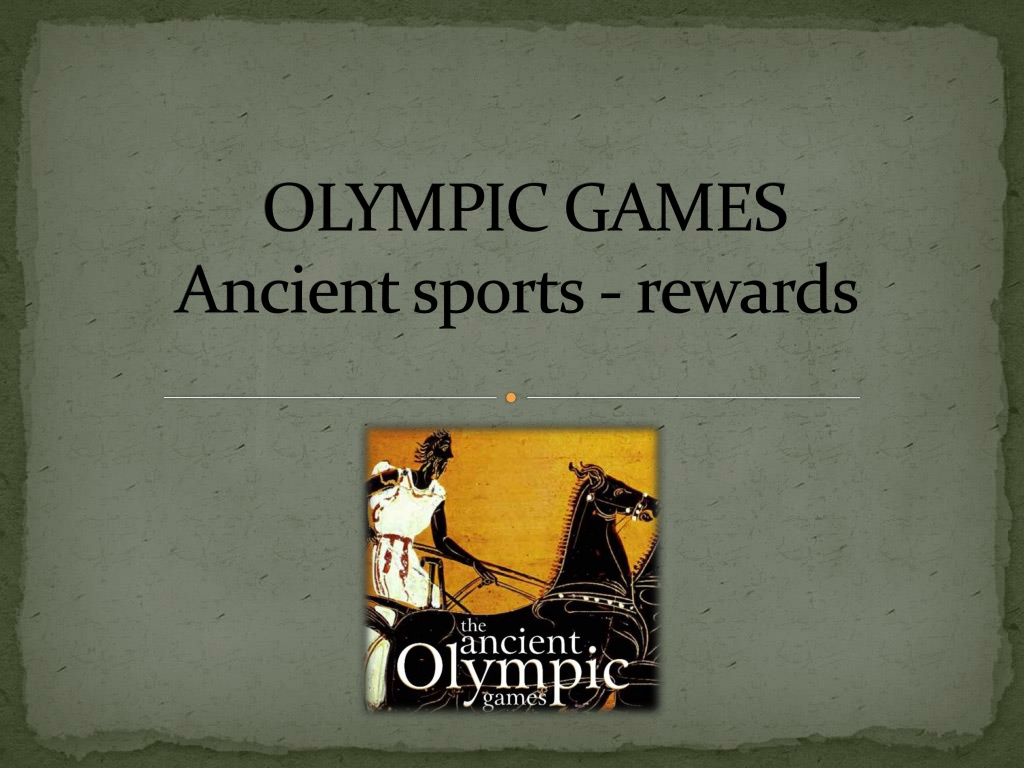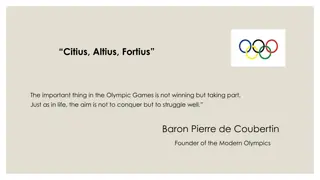OLYMPIC GAMES
The ancient Olympic Games, dating back to 776 BC, featured a variety of sports including running, combat, and the pentathlon. Athletes competed in events such as sprinting, wrestling, boxing, and the pentathlon which consisted of running, long jump, discus throw, javelin throw, and wrestling. These games hold a significant place in history and have left us with a rich cultural heritage through literature and archaeological discoveries.
Download Presentation

Please find below an Image/Link to download the presentation.
The content on the website is provided AS IS for your information and personal use only. It may not be sold, licensed, or shared on other websites without obtaining consent from the author.If you encounter any issues during the download, it is possible that the publisher has removed the file from their server.
You are allowed to download the files provided on this website for personal or commercial use, subject to the condition that they are used lawfully. All files are the property of their respective owners.
The content on the website is provided AS IS for your information and personal use only. It may not be sold, licensed, or shared on other websites without obtaining consent from the author.
E N D
Presentation Transcript
OLYMPIC GAMES Ancient sports -rewards
The information we have today about the ancient Games come mainly from the many descriptions of them in ancient literature, as well as from objects found at archeological digs (statues, vases, coins and tools). Olympic
The Olympic Games have a long history, which goes back to ancient times. The first written mention dates back to 776 BC. The athlete:Identification of the athlete by his nakedness, a sign of balance and harmony. Gymnasium education of the body and the mind. and palaestra: the
Running The only event recorded at the first thirteen games was the stade, a straight-line sprint of just over 192 metres. The diaulos, or two-stade race, is recorded as being introduced at the 14th Olympiad in 724 BC. A third foot race, the dolichos, was introduced in the next Olympiad. Accounts of the race's distance differ, around 7.5 km to 9 km, although it may have been lengths ratherthan laps and thus half as far. The last running event added to the Olympic program hoplitodromos, introduced in 520 BC and traditionally run as the last raceof the games. was the
Combat Wrestling (pale) is recorded as being introduced at the 18th Olympiad. Three throws were necessary for a win. A throw was counted if the body, hip, back or shoulder (and possibly knee) touched the ground. Boxing (pygmachia) was first listed in 688 BC, the boys event sixty years later. It appears body-blows were either not permitted or not practised. The Spartans, who claimed to have invented boxing, quickly abandoned it and did not take part in boxing competitions. The pankration was introduced in the 33rd Olympiad (648 BC). Boys' pankration became an Olympic event in 200 BC, in the 145th Olympiad. As well as techniques from boxing and wrestling, athletes used kicks, locks, and chokes on the ground.
Pentathlon The competition made up of five events: running, long jump, discus throw, javelin throw and wrestling. The pentathlon is said to have first appeared at the 18th Olympiad in 708 BC. The competition was held on a single day, but it is not known how the victor was decided, or in what order the events occurred, except that it finished with the wrestling. pentathlon was a
Long jump Discus-thrower
Equestrian Horse racing and chariot racing were the most competitions in the games, due to only the wealthy being able to afford the maintenance transportationof horses. These races different events: the four-horse chariot race, chariot race, and the horse with rider race, the rider being hand picked by theowner. The four-horse chariot race was the first equestrian event to feature in the Olympics, being introduced in 680 BC. prestigious and consisted of the two-horse
Rewards Winners did not receive any financial reward. The athletes who won at the Olympic Games, were rewarded by a wild olive leaf crown.
Fame Olympic important figures in their town or city, where they often took on a political role. The glory of the victorious athlete brought reflected glory to all the inhabitants of his home town. When he returned from the Games, he was given a hero s welcome and received numerous benefits for the rest of his life. To show that he had become famous, the victor had the right to have a statue of himself erected. He could also ask a poet to write verses telling of his feats. Because they were proud of him, his fellow citizens coins with his effigy on them, so as not to forget him and to make him known throughout the Greek world. champions became sometimes made papyrus
Thanks for your attention! Alerta Mara Archontaki Chrissa Georgilaki Athina
ibliography https://en.wikipedia.org/wiki/Ancient_Olympic_Games#Events https://web.archive.org/web/20040602233340/http://minb ar.cs.dartmouth.edu/greecom/olympics/ http://www.museum.upenn.edu/new/olympics/olympicint ro.shtml Miller, Stephen G. (8 January 2006). "Ancient Greek Athletics". Yale University Press. p. 33. Archived from the original on 15 November 2017. Retrieved 15 November 2017 Gardiner, Edward Norman (15 November 2017). "Greek athletic sports and festivals". London : Macmillan. Archived from the original on 11 March 2012. Retrieved 15 November 2017























